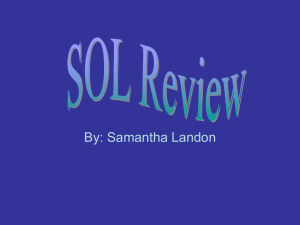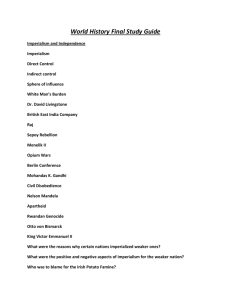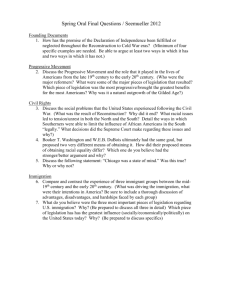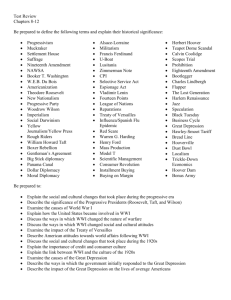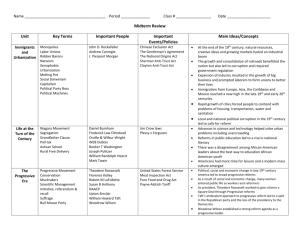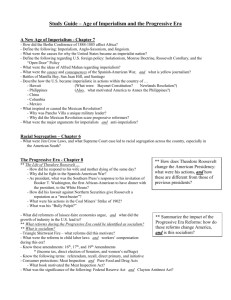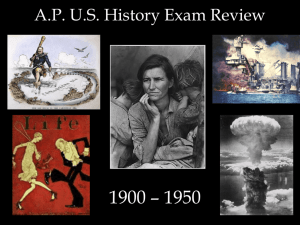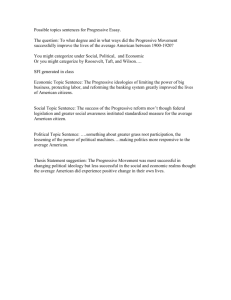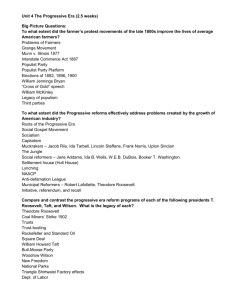Grade 11 – United States History II
advertisement
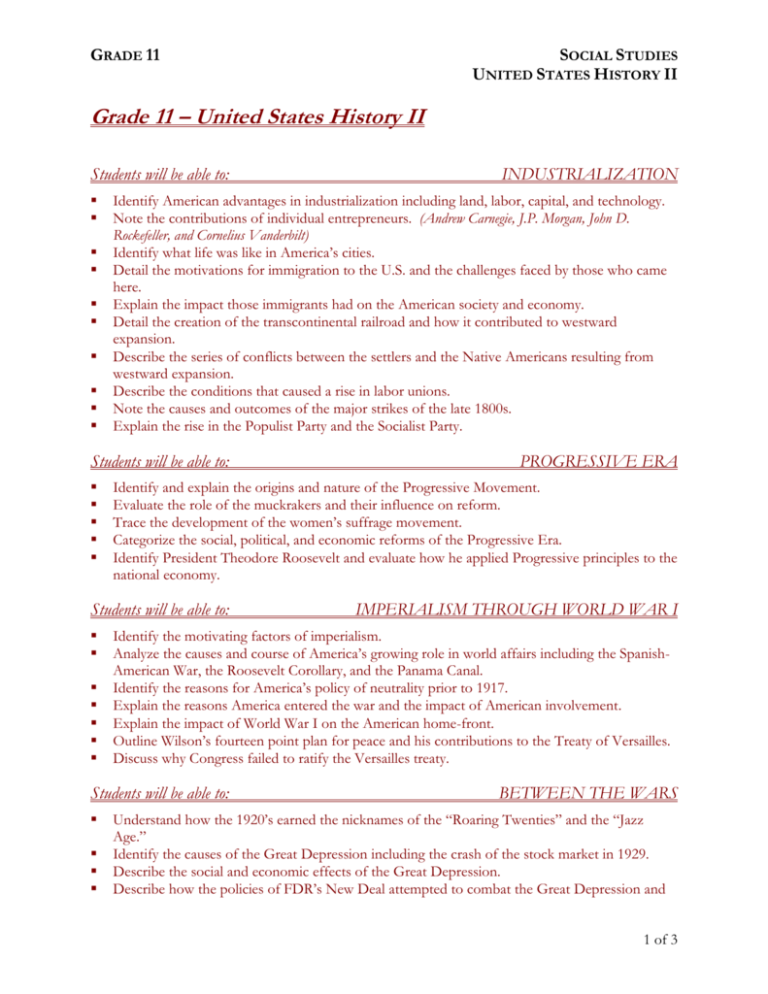
GRADE 11 SOCIAL STUDIES UNITED STATES HISTORY II Grade 11 – United States History II Students will be able to: Identify American advantages in industrialization including land, labor, capital, and technology. Note the contributions of individual entrepreneurs. (Andrew Carnegie, J.P. Morgan, John D. Rockefeller, and Cornelius Vanderbilt) Identify what life was like in America’s cities. Detail the motivations for immigration to the U.S. and the challenges faced by those who came here. Explain the impact those immigrants had on the American society and economy. Detail the creation of the transcontinental railroad and how it contributed to westward expansion. Describe the series of conflicts between the settlers and the Native Americans resulting from westward expansion. Describe the conditions that caused a rise in labor unions. Note the causes and outcomes of the major strikes of the late 1800s. Explain the rise in the Populist Party and the Socialist Party. Students will be able to: IMPERIALISM THROUGH WORLD WAR I Identify the motivating factors of imperialism. Analyze the causes and course of America’s growing role in world affairs including the SpanishAmerican War, the Roosevelt Corollary, and the Panama Canal. Identify the reasons for America’s policy of neutrality prior to 1917. Explain the reasons America entered the war and the impact of American involvement. Explain the impact of World War I on the American home-front. Outline Wilson’s fourteen point plan for peace and his contributions to the Treaty of Versailles. Discuss why Congress failed to ratify the Versailles treaty. Students will be able to: PROGRESSIVE ERA Identify and explain the origins and nature of the Progressive Movement. Evaluate the role of the muckrakers and their influence on reform. Trace the development of the women’s suffrage movement. Categorize the social, political, and economic reforms of the Progressive Era. Identify President Theodore Roosevelt and evaluate how he applied Progressive principles to the national economy. Students will be able to: INDUSTRIALIZATION BETWEEN THE WARS Understand how the 1920’s earned the nicknames of the “Roaring Twenties” and the “Jazz Age.” Identify the causes of the Great Depression including the crash of the stock market in 1929. Describe the social and economic effects of the Great Depression. Describe how the policies of FDR’s New Deal attempted to combat the Great Depression and 1 of 3 GRADE 11 SOCIAL STUDIES UNITED STATES HISTORY II forever enlarged the size and scope of the federal government. Students will be able to: Explain the strength of American isolationism after World War I and analyze its impact on United States foreign policy. Analyze how German and Japanese aggression contributed to the beginning of World War II. Identify and explain the significance of key battles, strategies, and events of World War II including Pearl Harbor, D-Day, and island-hopping in the Pacific. Debate the arguments for and against the use of atomic weapons against Japan. Explain important domestic events that took place during the war including the internment of Japanese-Americans and the struggle for justice at home for African-Americans. Students will be able to: POST WAR AMERICA Analyze the causes and consequences of important domestic Cold War trends. (baby boom, education, and consumerism) Recognize the similarities between the Fair Deal and the New Deal. Describe the impact of organized labor in post war America. Analyze the effects of Senator Joseph McCarthy’s anticommunist campaign on the American public. Explain the domestic response to the space and arms races. Identify McCarthyism and its affect on American institutions. Describe the origins, goals, key events, and accomplishments of the Civil Rights Movement. Students will be able to: COLD WAR Explain why 1945 was a critical year in international relations and identify the superpowers’ conflicting postwar goals. Compare and contrast American and Soviet economic and political systems. Explain how the U.S. policy of containment was designed to stop Soviet communist expansion. Analyze the effects of U.S. policies designed to stop Soviet communist expansion. Describe the causes and the consequences of the Korean War and the Vietnam War. Explain how American foreign policy decisions contributed to the end of the Cold War. Assess the successes and failures of Presidents Truman, Eisenhower, Kennedy, Johnson, Nixon, Ford, Carter, and Reagan. Students will be able to: WORLD WAR II CONTEMPORARY AMERICA Describe some of the major economic and social trends of the late 20th century & early 21st century. Assess the foreign and domestic policies of the G.H.W. Bush, Clinton, and G.W. Bush presidencies. Explain the importance of the 2000 presidential election. Analyze the course and consequences of American interventions in the Balkans, Somalia, and Iraq. 2 of 3 GRADE 11 SOCIAL STUDIES UNITED STATES HISTORY II Explain how American foreign policy has led to the rise of global terrorism. 3 of 3
